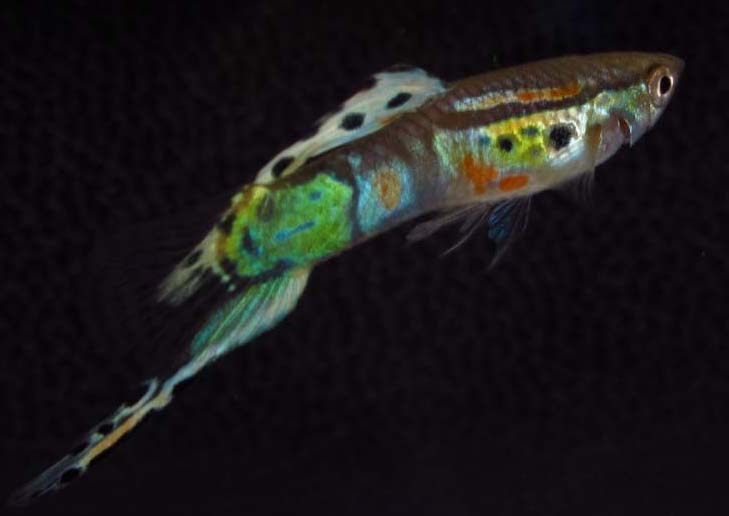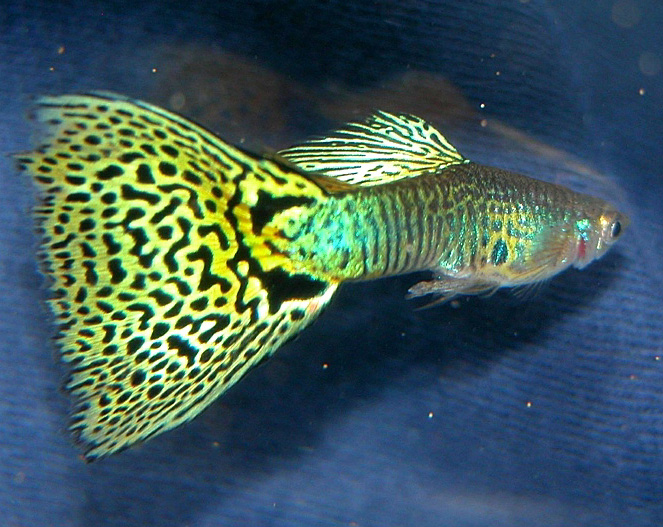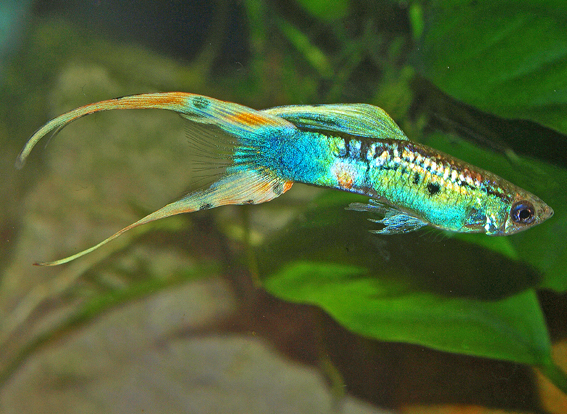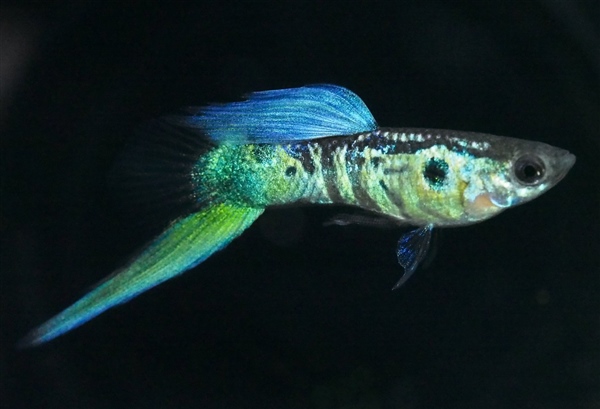Art XXI
Research and study of the Vienna Emerald pattern
RUBRIEK: Guppy Kweek English Translation
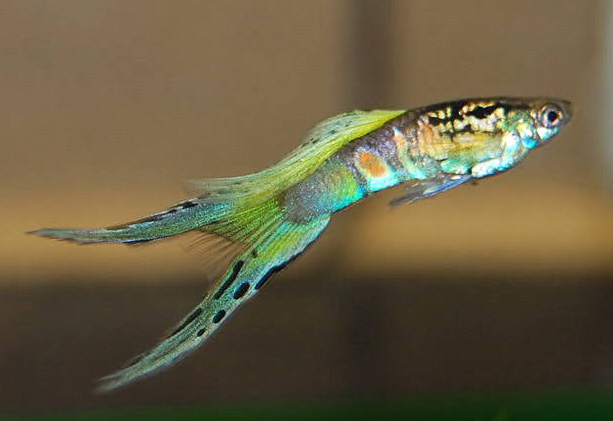
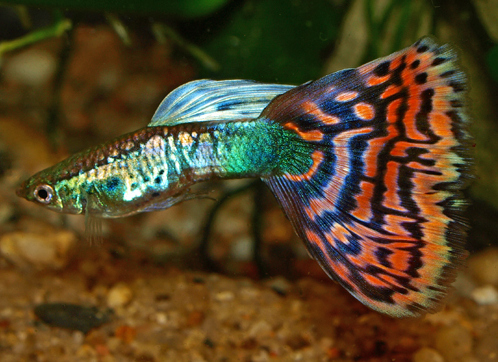
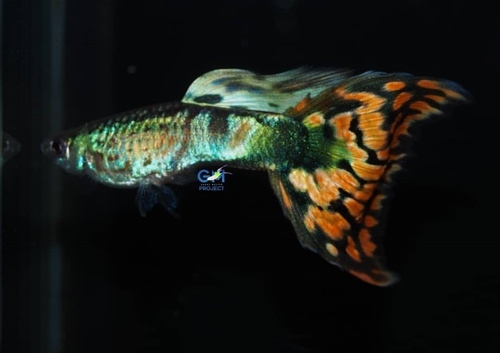
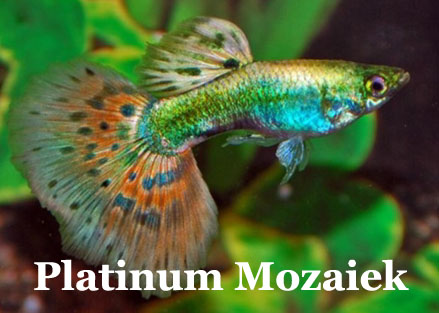
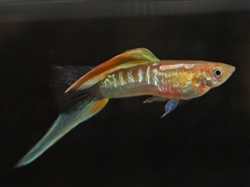
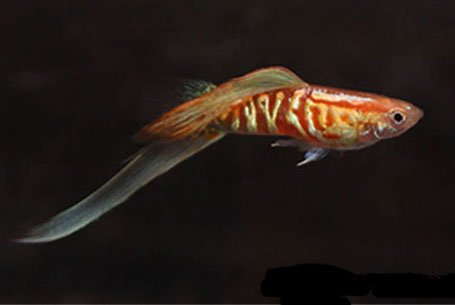
The Vienna Emerald is one of the oldest gup strains. Its origins date back decades when triangle tails were cultivated in Austria. In such multi-color mosaic strains, a few guppies were found to have a special, meander drawing on the rear body, comparable to "a ribbon that is moving by a breeze" or with "a river meandering across a lowland ". Both by name and by analogy, the Wiener Smaragd is therefore of European origin. The finest specimens also showed a spotting pattern in the fore body and in the cau-dal root. In the front body sometimes as a zigzag line , whether or not ac-centuated by the presence of a silver to gold shine on the back: the Schim-melpfennig Platinum which was then discovered almost simultaneously in Germany. In the caudal end, often like a Peacock's Eye : a black spot sur-rounded by a silvery circle. When you think of a peacock, you think of the colors blue and green , so that the most spectacular fish were also in the-se basic colors. Hence the ultimate name of Emerald .
As already mentioned, the first Vienna Emeralds were triangles with multi-colored mosaic tail fins. At the same time, this caused a number of pro-blems, because those busy patterns in the caudal fin demanded too much attention to the detriment of the more subtle drawings on the body. It was soon realized that Double swords (together with Bottom swords and Up-per swords) brought these out better. The strain made a comeback in the 80's thanks to Australian breeders to the extent that it has been the basis of most Double Sword strains ever since. For yellow, red and also green shades, the blonde specimens are especially suitable, because they put a golden sheen over the gup, which emphasizes these colors even more. New variations are the Bunt / Bund , in which the meander drawing is plotted in a wine red to deep burgundy. I call this Caramel because it reminds me of a dessert dripping with a caramel sauce. It makes the contrast sharper, but the color nuances less refined. Judge for yourself by comparing the blonde bottomswords here on the left. This second generation is generally called Vienna Emerald , because the focus of the breeding has shifted to English-speaking countries.

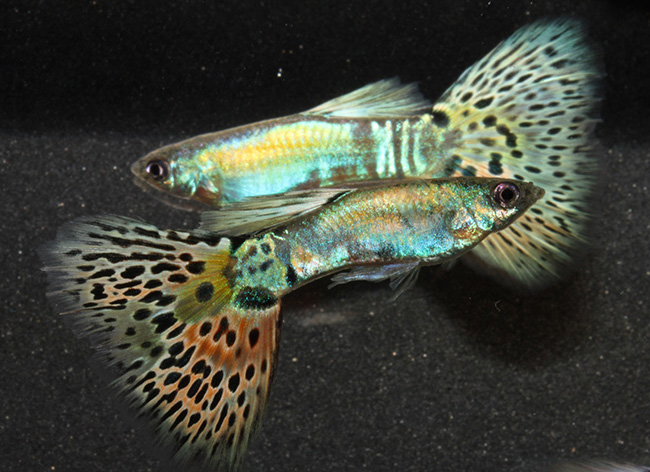
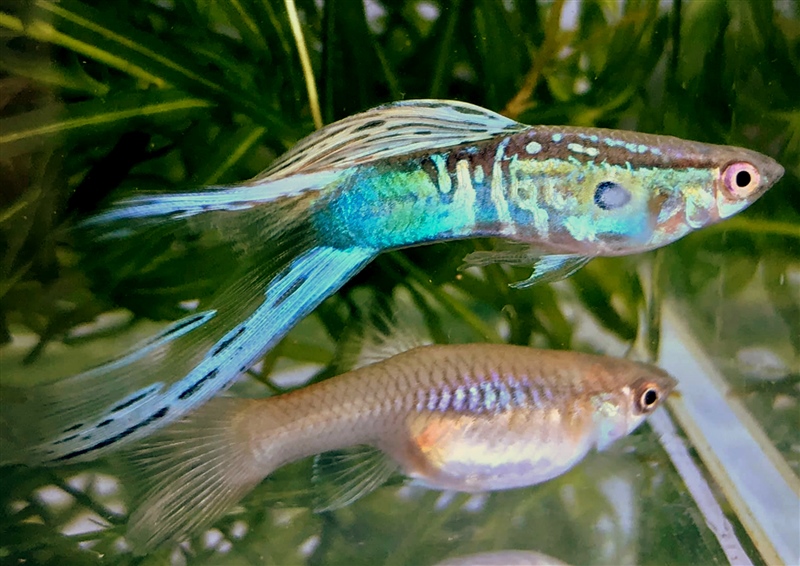

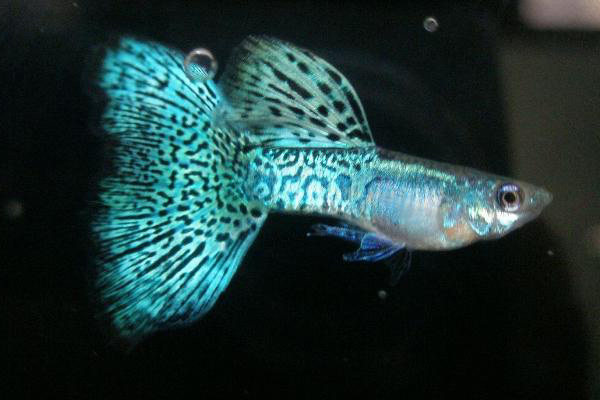
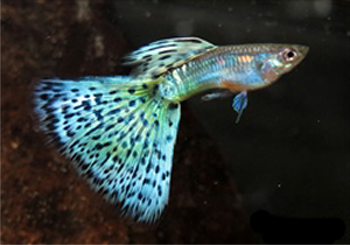
This strain underwent the latest development in Japan, where it arrived in the 1990s via imports from Singapore and Taiwan. Asians are less dogma-tic and conservative in breeding, and they often give more flowery and lyri-cal names to their breeding results. A staff member of a Japanese guppy shop who loved the song "An Old-Fashioned Love song" by the equally old-fashioned rock band Three Dog Night, called this tribe Old-Fashioned . This was considered an appropriate name in Japan, because in its multi-colored variability it had an "old-fashioned" appearance, resembling more to the wild guppy more than that of the most "modern" tribes of the time.
But that did not mean that this strain should have no connections with these more "modern" strains. Surfing on the Net in the numerous cros-sings that Easterners dare to make with more application, I could find associations in photos between this Old-Fashioned on the one hand, and Blue Grass and Snakeskin on the other. On the left a number of photos that clarify this. In addition, the same pattern of meandering on the rear body regularly appears in the multi-color Triangles. An essential question here is whether this meander pattern would have nothing to do with the Zebri-nus pattern, because in the first the stripes are more arbitrary in length and thickness, while in the secondvthe stripes usually run almost nicely vertically parallel to each other.
This has its reasons why people do NOT want to recognize or make this connection between the two. The first has to do with the need to clearly distinguish the strains from each other, so that there is actually no interest in the mixing types that illustrate certain transitions between them. The second reason has to do with what I personally call the ugly habit of "labe-ling": one likes to assign one particular characteristic to one single gene / gene pair. The latter shows a simplistic view of genetics, while the former shows a very stationary view of how genetics works. In reality, genes work together in networks, and so the different patterns slip INTO each other. The only way to keep an overview of this, is to find RELATIONSHIPS be-tween the patterns, instead of clinging to what ultimately turn out to be just markers on the boundary between those patterns.
The Genalogy, with the history of the development of the guppy strains over time, can help us in this case very well. In my treatment The genetic Genealogy Table of the gyppy strains I have already mentioned that the old tribe Pauper lays on thebase of the later Wiener Smaragd; and that the Bird Eye together with the V lats on the base of the later Snakeskins. These Spots / Bird Eyes / Peacock Eyes is what the ancestors of Wiener Smaragd and Snakeskin have in common, and thus show up in ALL "mo-dern" strains that are derived from them. View the photos of Pauper on the left, which illustrate this. Finally, a regression to it from my own silver blue Double Sword strain in more flickering colors to complete te set.
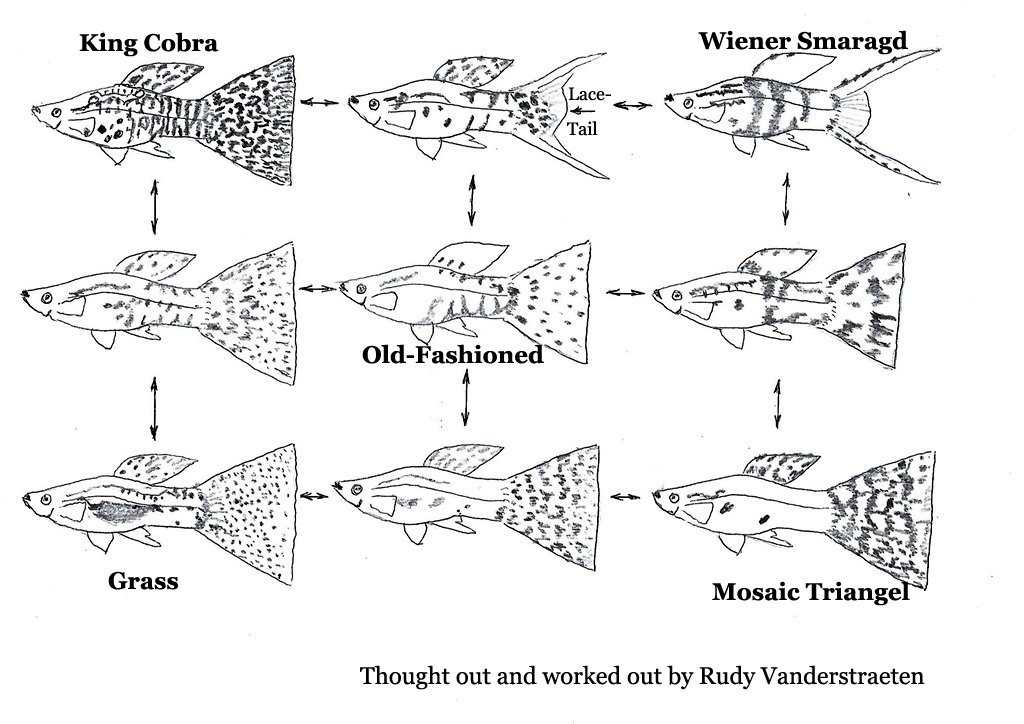
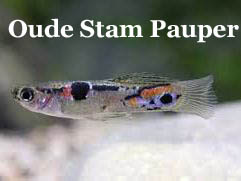

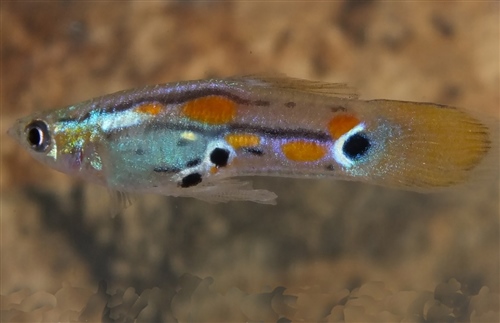
I have illustrated HOW different strains can slide into each other in the drawing here above. There are associations of the Wiener Smaragd with the Mosaic Triangle , the Snakeskin or King Cobra and the (Blue) Grass . If we get specimens with smaller swords and a larger set of tail fin with speckled patterns in the Double Swords, this indicates a shift towards the King Cobra. Sometimes one can even recognize the onset of a Lace tail , another primal gupstrain that lays on the base of the Snakeskin (Lace). The more the Wiener Emerald slips into an "ordinary" Mosaic, the more the swords will make place for triangle tails, and the more the typical meande-ring disappears for a sporadic spot or line here and there. Also between the Grass and the Mozaiek there are a lot of intermediate shapes to be distin-guished, with the first the typical Nike drawing fading, and with the second the spots in the tail are changing into dots.
Between all these mixed forms , the Old-Fashioned is almost in the mid-dle: it has a little bit of everything, but not in pronounced but in "subtle" form and gradation. It is understandable that purists do not recognize him as a real strain. In part, this also allows one to understand the "fright" that exists in guppy growers to see the characteristics of a strain shift away. And that partly also explains the conservative reflex to cling to the Standards . Too far-fetched and improper inter-crossings, can corrupt completely a strain, or even let it lost.
On the other hand, it also applies that a tribe can be impoverished by con-tinuously and severely limiting its variations. One must try to find a middle between on the one hand the wisdom and expertise to respect certain li-mits, and on the other hand the sense of experiment and wonder to NOT let everything happen according to a predetermined plan. Guppy breeding is therefore a bit like life itself: one should not be too rigid in his views and be able to keep an open mind . But on the other hand, one should not start a guppy breeding as a complete chaos, because before one knows it, one will be stucked with guppies of objective less quality. Not every variation can claim the label of a strain, however much one would like to upgrade its "sweeties" subjectively with a certain pedigree. Not every boulder is a gemstone.
Now touch another polemic subject of the Vienna Emerald: the EGI - the Emerald Green Iridescent . This is an iridescent green-blue zone on the caudal end. It is sometimes suggested that the strain is named AFTER this characteristic. That is the question of what came first: the chicken or the egg. But in this particular case, that EGI is NOT a basic trait of this strain. Firstly, because the strain already existed and was DIFFERENTLY defined as the Wiener Smaragd, and therefore Vienna Emerald guppies can be found WITHOUT EGI.
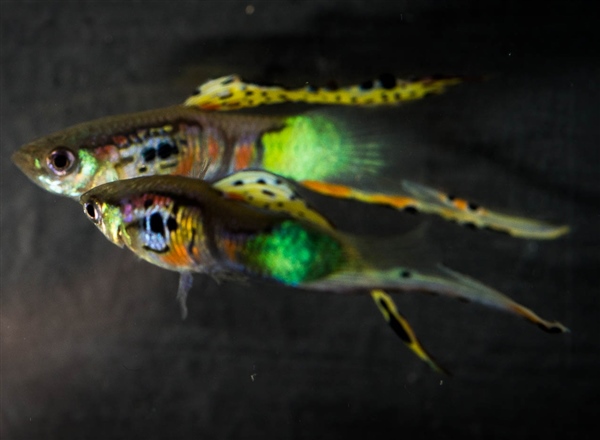

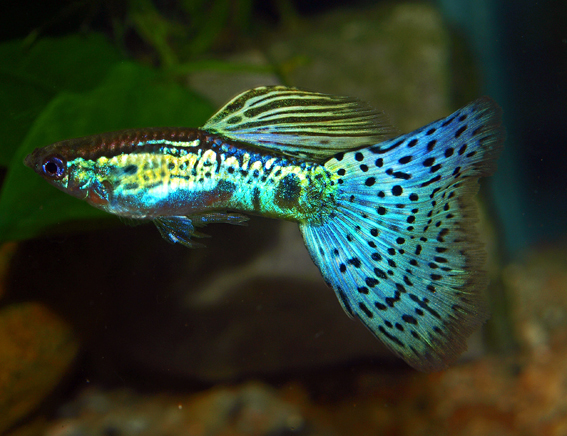
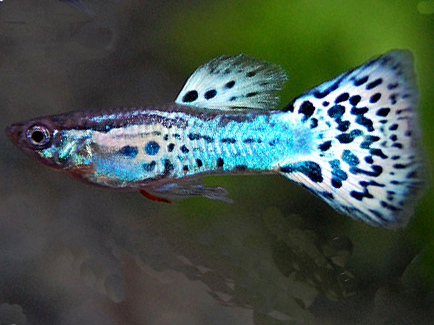
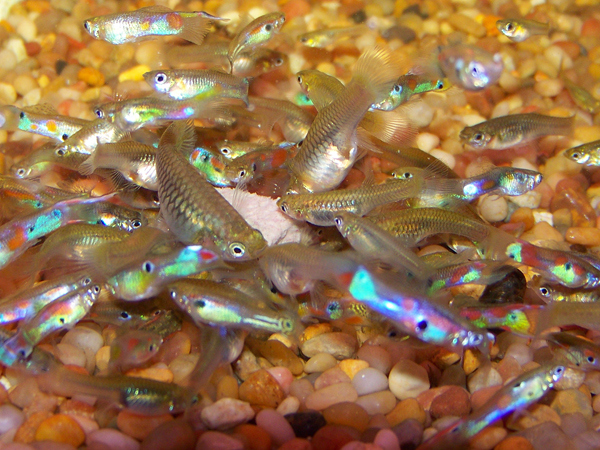

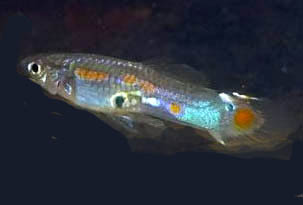
Secondly, because this EGI can be found even in the wild guppies, or in re-leased populations in places where the guppies did not exist before (see photos above left). Thirdly, because this EGI also occurs in OTHER "mo-dern" gup strains such as the Snakeskin, just to mention one. And last but not least, because the caudal end can also have such an iridescent zone in an OTHER color than green: blue, yellow, orange, purple, and even black.
Due to its great variability , the Wiener Smaragd is a "difficult" strain: it is not easy to breed a pair of identical males. Often the grower has a beautiful specimen that scores high in all competitions, but that only lasts 1 gup life, and that is short. In some cases, this strain may also suffer from poor ferti-lity, and will cross-breeding with other females be necessary. The double swords suffer less from this, so this is one more argument to prefer the double swords for the Vienna Emerald.
Considering the large number of possible combinations of colors and drawings, one would better judge this Wiener Smaragd or Vienna Emerald Double Swords for harmonious color drawings and drawings over the enti-re body, instead of mainly for the size of the swords as it is now. In the new generation of breedings of Vienna Emerald, the emphasis in upper and lower swords is increasingly shifted to accentuating the Emerald patterns on the body, although there is also a tendency to breed faded types with superlong swords. One cannot have everything.
One can thus "find" teoreticly from one strain ALL the other strains by adequate crossing, or "return" to the primal strains from which all "mo-dern" gup strains originate by regression , provided that its base contains enough genetic diversity. However, the genetic Big Bang in which all the gup strains originated from the "wild guppy" through decades of breeding, is moving more and more away from these primordial strains. At some point, one is too far from this core to be able to reverse the process to re-turn to the source . Hence not only the renewed interest in the wild gup-py every so many years, but also the need to cross back with it. After all, unilateral crossbreeding produces freaks that contain only a fraction of the gene richness that wild guppies possess. Wild guppies don't show this (phenotype), but they have a rich genepool (genotype).
Unlike most guppy enthusiasts / growers, I only grow two strains. And also unlike most breeders, I did not start breeding with selected fancy couples that I bought / received from other breeders: I built my strains from scratch that I selected in aquarium shops myself. This freed me from the manual and span services that go with it, as well as from the "psychological guilt" that sometimes results from it: gratitude is beautiful, but it should never go so far that in the name of that gratitude, for example, one should feel oneself obligated to adhere to the standards of the guppyclubs.
By navigating this independent course, I have given myself the opportunity to find new insights about genetics, which differ from the commonly pro-posed and propagated ones, but which rely on careful study of the guppy itself. No observation is therefore "anecdotal", because it can open the door to important insights. Because my fascination with this beautiful and interesting fish has remained just as vivid, since I first saw it as a 10-year-old in an aquarium in my dentist's waiting room.
